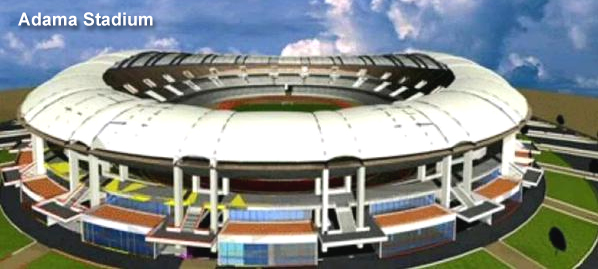Adama to build a new 80,000-seat Stadium
Adama, Ethiopia – The city of Adama is planning to build a new 80,000-seat stadium at a cost of 1.7 billion Birr ($82 million US), reported Ethiopian Football Federation (EFF) President, Juneydi Basha on his twitter account.
Ethiopia is currently undergoing a major Stadium construction boom.
A new 30,000-seat stadium is under construction in Gambella at a cost of 375 million birr (Just over 18 million US$). Similar projects are underway in Mekelle, Awassa, Nekemte, Dire Dawa and Woldiya among others. The big one of course, is the much awaited Addis Ababa Stadium (Adey Abeba) and Olympic village project slated to be completed in a couple of years time, while the recently CAF ratified Bahr Dar Stadium has already started hosting international competitive games.









after 10 or 20 years we will hold world cup in our great stadiums! don’t we?
the LAVA JDAW Sportsdesign National Stadium in Addis Abeba won the international competition.
the above shown Adey Abeba Stadium, Addis Ababa is not the competition winner.
The design team hopes that the government honours its own competition process and trusts its own decision to make a bold statement for a sustainable cost effective stadium for the peope of Ethoipia, designed by a local/international team of experts.
the design is also providing a new sportspark integrated into the urban fabric rather than a stand alone isolated building.
The matter is currently in court and the world is eagerly awaiting the decision. May justice and good design prevail.
http://www.l-a-v-a.net/projects/addis-ababa-national-stadium-and-sports-village/
Football and athletics-loving Ethiopians will have a new FIFA and Olympic-standard 60,000 seat stadium in Addis Ababa thanks to a competition winning design combining local identity with new technology.
LAVA, the LABORATORY FOR VISIONARY ARCHITECTURE, and DESIGNSPORT collaborated with local Ethiopian firm JDAW to win the international architecture competition for a national stadium and sports village, held by the Federal Sport Commission, Ethiopia.
LAVA, the LABORATORY FOR VISIONARY ARCHITECTURE, and DESIGNSPORT collaborated with local Ethiopian firm JDAW to win the international architecture competition for a national stadium and sports village, held by the Federal Sport Commission, Ethiopia.
LAVA went back to the very origin of stadium design with a sunken arena surrounded by grandstands formed from excavated material. This man-made crater is a clever remodelling of the existing terrain and generates efficient spaces, optimises environmental performance, minimises construction costs and integrates facilities within the existing landscape. ”
The design references Ethiopia’s world-famous excavated architecture – centuries old rock churches, dwellings and cisterns. We see the sports city as a natural extension to this heritage, one that will draw many more visitors to our beautiful country.
The Massob, an Ethiopian communal serving basket made from woven grass, inspired the façade material that wraps the stadium. The form of the stadium structure seen from the top view also recalls coffee beans, the main source of income in Ethiopia and the ‘Mother womb’, the skeleton of one of the first humans, Lucy, which is about 3.2 million years old.
The roof of the stadium, an intelligent membrane, appears like a cloud on the horizon of the vast Ethiopian sky, a lightweight tensile structure floating over the formed-earth landscape.
The masterplan by the JDAW/DESIGNSPORT/LAVA CONSORTIUM includes the IOC-standard stadium for FIFA matches, athletics events, concerts, religious and national festivals; and a sports village comprising indoor and outdoor aquatic centres, outdoor pitches, sports halls and arenas, dormitories and the headquarters for the Federal Sport Commission. Hospitality, retail and commercial zones will ensure that the precinct is vibrant throughout the year.
Tectonic structures and movement are the underlying concept for the masterplan. The breathtaking beauty of the surrounding Entoto Hills is the backdrop to a design that responds to the volcanic geology of the region. Gently undulating urban parkland follows the lines of the crater and is conceived as a continuous spatial experience strategically activated to balance movement, climate, experience and efficiency. A central plaza forms the heart of the project and a ridge connects all zones.
Giant solar powered umbrellas provide shade and shelter whilst pedestrian activated light and water features appear as fissures in the ground surface, providing way finding and creating animated art works.
Bosse, who was one of the lead architects of the Beijing Watercube whilst at PTW architects, has again combined new technology with traditional architectural principles. The façade patterns are digitally created through parametric modelling and are built with local materials.
With sustainable design features, maximum flexibility and capacity, and intelligent adaptability, the new facilities will make a valuable contribution to the local people, the nation and its culture, enhancing Ethiopia’s sporting profile and generating revenue.